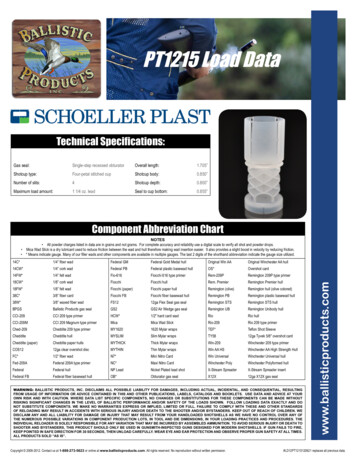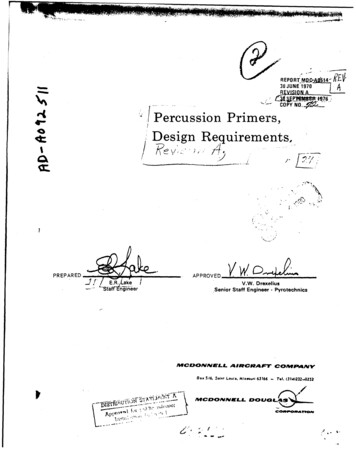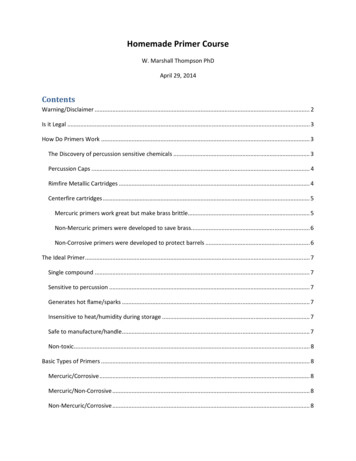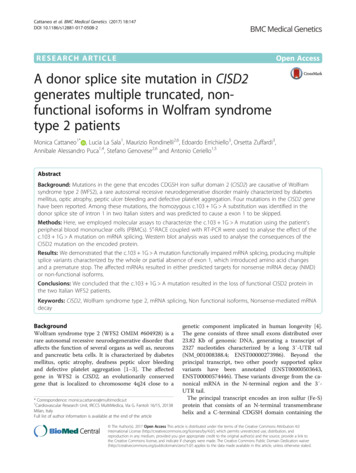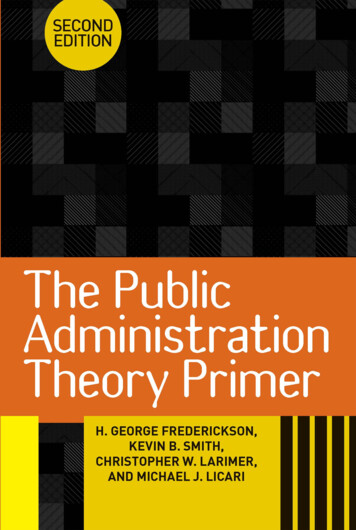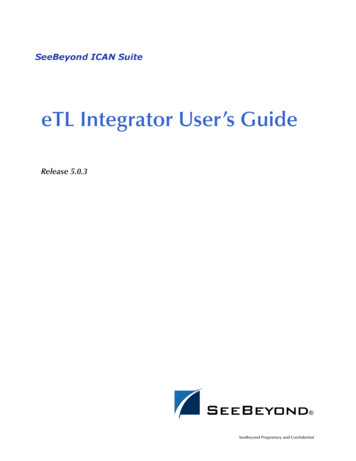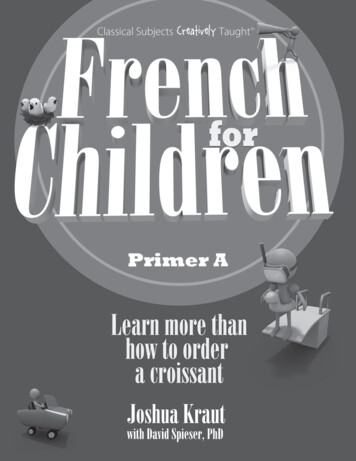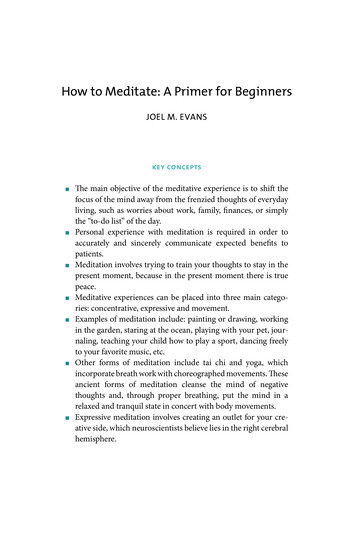
Transcription
How to Meditate: A Primer for BeginnersJOEL M. EVANSkey concepts The main objective of the meditative experience is to shift thefocus of the mind away from the frenzied thoughts of everydayliving, such as worries about work, family, finances, or simplythe “to-do list” of the day.Personal experience with meditation is required in order toaccurately and sincerely communicate expected benefits topatients.Meditation involves trying to train your thoughts to stay in thepresent moment, because in the present moment there is truepeace.Meditative experiences can be placed into three main categories: concentrative, expressive and movement.Examples of meditation include: painting or drawing, workingin the garden, staring at the ocean, playing with your pet, journaling, teaching your child how to play a sport, dancing freelyto your favorite music, etc.Other forms of meditation include tai chi and yoga, whichincorporate breath work with choreographed movements. Theseancient forms of meditation cleanse the mind of negativethoughts and, through proper breathing, put the mind in arelaxed and tranquil state in concert with body movements.Expressive meditation involves creating an outlet for your creative side, which neuroscientists believe lies in the right cerebralhemisphere.
IntroductionAfter reading and digesting the scholarly discussion on the myriad healthbenefits attributed to meditation, it is quite tempting for the busy physicianto simply tell his patients that they “need to meditate.” However, when thatrecommendation—no matter how sincere, well-meaning or intellectuallyappropriate—is given by a physician that has not himself learned to meditate,the recommendation becomes hollow, compared to the same recommendation from a regular meditator.Personal experience with meditation is required in order to accurately andsincerely communicate the benefits you expect an individual patient, with hisor her unique needs, to experience, and it is impossible to present that information with clarity unless you “know” how the practice of meditation haseffected your own life and health. Once you can speak using the authority ofpersonal experience as part of the basis for your “meditation prescription,” aswell as actually guide your patients as you provide specific instructions on howto meditate, it will be extremely hard for your patients not to pick up on theconviction behind your recommendations, making them far more likely to beimplemented. After all, doesn’t every physician want his patients to follow hisadvice so they can achieve better health? Learning to meditate and starting aregular meditation practice are vitally important ways to improve the lives ofpatients and physicians alike.The main objective of the meditative experience is to shift the focus of themind away from the frenzied thoughts of everyday living, such as worriesabout work, family, finances or simply the “to-do list” of the day. There arecountless ways, or techniques, to do this.What is Meditation?Meditation involves trying to train your thoughts to stay in the presentmoment, because in the present moment there is true peace. Thoughts of thefuture (what can/might/will happen, leading to fear or anxiety) or of the past(what did or might have happened, leading to sadness, depression, anger, orjealousy) prevent us from feeling the peace that is in the present moment. Inother words, being totally focused in the present moment means that you donot think about the past or the future, and are freed (for as long as the meditation session lasts) from the negative emotions (stress) that accompany thosethoughts.
EXAMPLES OF MEDITATION Can you think of an activity in which you totally lose track of time?When your attention is so focused that you say, “I don’t know wherethe time went?” Examples might be: painting or drawing, working inthe garden, staring at the ocean, playing with your pet, journaling,teaching your child how to play a sport, dancing freely to your favorite music, etc. I found that when I was in the operating room performing surgery, I was so focused that my operations became truemeditations. All of these situations are meditative experiences because there are nothoughts about the past or the future; the mind is thinking only of thepresent moment. So as you reflect on the experience(s) in your life where you lost trackof time, you will realize that you also lost track of whatever was inyour life that was causing you stress, whether it was a toxic relationship, a chronic illness, or the sadness that comes with grief or loss.CATEGORIES OF MEDITATIONIf you are lucky enough to have a hobby or some sort of activity in which youengage on a daily basis and that makes you lose track of time, consider yourselfone of the lucky people who have a regular meditation practice without knowing it. However, the rest of us (the majority of people on the planet) need tocreate dedicated time in our schedule to engage in a formal activity to quiet themind. As you can tell from the examples listed above, these experiences can beplaced into three main categories: Concentrative Movement ExpressiveThese three forms of meditation have been used for centuries in differentcultures and religious traditions. I will give examples of techniques for eachcategory, and I suggest you experiment with them all so that you have enoughexperience to know what you like best (so it can become the start of your regular meditation practice), as well as to know how to best explain them to yourpatients.
How to Meditate First, scheduling time to meditate is of the utmost importance. We all lead busy lives and, despite the best of intentions, without adedicated time for an activity, life often gets in the way and the activity never happens. (Think of the difficulty most people have findingthe time to exercise unless they commit to a certain schedule.) Therefore, a meditation practice starts with finding the time on a dailybasis. The good news here is that not a lot of time is required.A beginner can start with just a few minutes a day, eventually getting to20 to 30 minutes a day as the benefits to the meditator become so obvious thatit becomes the most important part of his or her day.CONCENTRATIVE TECHNIQUES I will discuss concentrative techniques first, becausethey are ones that are most often described, taughtand practiced. They all involve active concentration, consciouslyfocusing the mind on something specific. Examplesof this type of meditation include staring at thedance of a candle flame, continuously repeating aword to yourself (such as peace, love or God) orsimply following your breath. The goal is to concentrate and try toignore the other thoughts that will unfortunately pop into your head. The secret is to allow those thoughts to come and to let them go by notallowing the mind to get caught up in them.Tips for Applying the Concentrative Techniques Don’t keep thinking of an unpleasant incident, startgetting worked up, begin feeling angry or hurt all overagain and begin to plan your revenge. That is not ameditative experience, but serves as an illustration ofhow a thought that arises, which is of a negative incident, is given additional power by thoughts of theemotions associated with it (how you feel) as well asthe thoughts of how to achieve retribution.
Instead of thinking that way, try your best to simply note that this is athought that is occurring, and do your best to refocus your attentionon the candle and not get stuck in the drama of the bad experience.This may be difficult to do at first, but with practice it certainly can bedone, although rarely to total perfection, except by yogis or monks. If you need proof of the usefulness of these techniques, just ask anexperienced meditator, who will likely be happy to share his or hersuccess stories as well as the challenges that never fully go away.Positioning Before starting, it is important to positionyourself properly, which means that youshould be sitting comfortably, not lying down. Sitting in a chair is fine; just keep your feet onthe floor. Sitting on the floor works just as well,with or without a cushion, but try to keep yourback as close to straight as you can withoutpain or a lot of effort.You should not be distracted by tight clothing and your shoes shouldbe off.A quiet place is best for concentrative work, as is a comfortabletemperature.Many regular meditators like to create a special place to meditateand feel they benefit from sitting in front of things that have specialmeaning, such as pictures of loved ones, sacred objects, or crystals(amethyst is reported to enhance meditation).While it is appropriate to try to achieve these “ideal” conditions, oneof the wonders of meditation is that it can occur anywhere and everywhere, even in the harshest of conditions, and that even true beginners have had effective meditations sitting on the ground outdoors inthe noisy chaos of a United Nations refugee camp.Quieting the Mind The final step in preparing for a quiet,concentrative meditation is to performa technique that will help quiet themind. After getting comfortable (as describedabove), simply take your right hand and
hold the center of your palm approximately 3 to 4 inches away fromthe spot on your forehead that is above your nose at the level of and inthe middle of your eyebrows. Close your eyes and rotate your hand so that the center of your palmmakes the outline of a circle that is the size of a quarter. Move yourhand toward your left, such that if an observer were facing you, yourhand would be moving in a clockwise direction. If, as you move your hand, you gradually enlarge the size of the circle,that is not a problem. People may experience different sensationsfrom this, such as a feeling of heat coming from their hand to theirforehead, but almost everyone finds that it helps quiet the mind.When you feel your mind has quieted down a little, meaning you arenot paying much attention to any thoughts that may be arising, it istime to start focusing on the object of your concentrative meditation(looking at a candle, repeating a prayer, word or phrase, or focusingon the breath).FOCUS ON THE BREATH The most popular concentrative meditation is to focus on the breath. This is extremely versatile, since no supplies (like a candle) are needed,and it can be done wherever we are. The way this meditation is performed is to simply focus on yourbreath as it comes in and out of your body. Try breathing in through your nose and out through your mouth(don’t worry about doing this if your nose is stuffed), being aware ofthe air coming in and going out. By keeping your focus on the breath you prevent other thoughts fromcoming in. If they do, simply let them go as best you can, and returnto concentrating on your breathing. Try to do this for a minute or two when you first start, and continuefor longer when you feel you are able.VARIATIONS ON A THEME There are many variations to this most basicscript. It can be done in silence or with music thatyou find relaxing. If you find your focus drifting from your breathto the music, allow it to happen—it is just anotherform of meditation.
You may feel you can control your mind better by adding the mentaldiscipline of repeating in your mind a word or phrase in coordinationwith your breathing. An example would be the phrase “soft belly,” thinking of the word “soft” on the in breath and “belly” on the out breath. Another way to structure the meditative process is, after getting comfortable and performing the hand motions previously described, to gothrough a prescribed pattern of thinking before starting the concentrative part of the meditation (in this case, the focusing in the breath.䊊An example of this is the pattern of thought that I personally useevery day, which I offer here for you to use as described, or tomodify to your liking.䊊I share this with you not because I want you to think a certain waybut because you might find it helpful.䊊This pattern of thinking helps me quiet my mind before startingmy concentrative meditation by getting my negative thoughts outof the way so that they are less likely to intrude during my meditation time.Expressing Gratitude Specifically, I begin each of my meditations by expressing gratitudefor all that I have in my life, both the pleasant and the unpleasant. This forces me to try to find positives in the challenges I face, helpingme to diminish, sometimes just ever so slightly, the drama with whichthe circumstances are associated. I then try to get to a place of surrender, where I work on making myselfbelieve that I can’t consciously understand or control the events of mylife. I have found that no longer lamenting “why me?” when life getsrough forces me to accept the situation at hand and frees up a lot of mymental energy, enabling me to focus forward on finding solutions. This ritual, which I perform every morning before starting the concentrative piece, clears my mind and prepares me for a more effective,deep and powerful meditation experience.SETTLING INTO THE MEDITATIVE MOMENT If sitting and thinking seems quite difficult foryou, then you might be best served by firsttrying a movement meditation, where thereare no instructions other than to move! That’scorrect: all you have to do is just move.
That means you can shake your body wildly, or dance (modern orballroom or tribal or ethnic) around the room to loud music that youreally like. This is probably best done with no one else around (onemight be self-conscious, as this could look quite silly to an observer).See how you feel after 5 minutes . . . if you want to continue, do so. Afterwards, try to keep still for a few minutes, paying attention toyour breath. Don’t be surprised if emotions come up while you areshaking or dancing. This is not an uncommon occurrence, especiallyif you have emotions just below the surface that have not yet beenaddressed. Becoming emotiona
lar meditation practice), as well as to know how to best explain them to your patients. How to Meditate First, scheduling time to meditate is of the utmost importance. We all lead busy lives and, despite the best of intentions, without a dedicated time for an activity, life oft en gets in the way and the activ- ity never happens. (Th ink of the diffi culty most people have fi nding the .File Size: 843KBPage Count: 9
